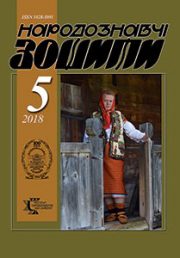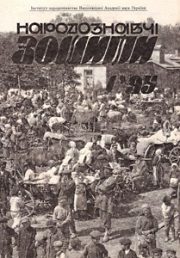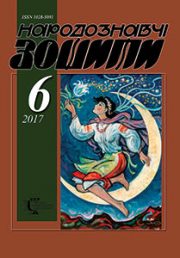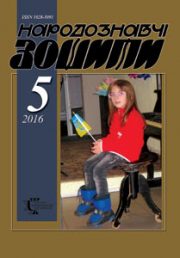The Ethnology Notebooks. 2022. № 4 (166), 790—797
UDK 930.2:39(477)-051
DOI https://doi.org/10.15407/nz2022.04.790
THROUGH THE PRISM OF ETHNIC LIFE: FROM THE CREATIVE IDEAS OF HANNA HORYN
SAPELYAK Oksana
- ORCID ID: https://orcid.org/0000-0001-8111-6563
- Candidate of Historical Sciences, Senior Research Associate,
- Institute of Ethnology of the National Academy of Sciences of Ukraine,
- Department of Modern Ethnology,
- Active Member of the Shevchenko Scientific Society,
- Prospekt Svoboda, 15, 79000, Lviv, Ukraine,
- Contacts: e-mail: oksana.sapelyak@gmail.com
Abstract. Historiography is an important area of Ukrainian ethnological science. However, monographic investigations of the creativity of Ukrainian scientists, which have been silenced for many years, are extremely insufficient, so now it should take a priority place in the research work of researchers. It is about the urgent need to spread knowledge about personalities of Ukrainian culture. After all, from 1933, domestic science, in particular ethnology, was declared nationalistic by the Soviet regime. The Ukrainian Academy of Sciences in Kyiv was destroyed, and ethnologists came under severe repression: persecution, executions and prisons.
In Lviv, where it operated from 1893 in fact, the All-Ukrainian Academy of Sciences — Shevchenko Scientific Society during the occupation (1914-1915), scientific activity was prohibited, many materials were destroyed. With the arrival of the Soviets in Galicia in 1939 the activity of NTSH was stopped, the property was confiscated. After the Second World War, ethnological research in Lviv began to be conducted in the Museum of Ethnography and Artistic Craft created by the authorities under the close supervision of communist ideologues, who theoretically «directed» all publications to prove the unity of the «fraternal» Russian and Ukrainian peoples, the need for mutual penetration of their cultures, «benefits» influence of Russian scientific thought on Ukrainian.
Therefore, studying the activities of Ukrainian ethnologists is one of the undesirable, actually forbidden topics. Only the proclamation of the restoration of the Independence of Ukraine created the conditions for the removal of the thematic «Procrustean bed». Although, in the harsh conditions of ideological pressure, Ukrainian ethnologists managed to preserve the national character of their works, to choose permits for studies of subjects necessary for the preservation of knowledge of folk culture, is a question that is of considerable interest and requires detailed study.
After all, we are talking about half a century of hard work during the difficult time of denationalization: ethnographic and folklore material was recorded, the museum’s rich collection was preserved and replenished with valuable artifacts of national culture, Ukrainian folk culture was popularized… One of the scientists of that period, who worked tirelessly in the direction of identifying specifically national characteristics of Ukrainian towns and villages was Anna Horyn. The object of this publication is to outline the scientist’s contribution to ethnological science, and the subject is her publication. The methodological basis is the principle of historicism and analysis. Using the method of historical-systemic analysis, the importance for Ukrainian science and culture of highlighting the personalities of Ukrainian ethnologists, in particular the activities of Anna Horyn, has been clarified.
Keywords: ethnology, historiography, ethnic life, personalities, national culture and science.
Received 9.07.2022
REFERENCES
- Kyrcziv, R. (2011). Ethnographic and folkloristic activities of the «Russian Trinity». Lviv: IN NANU [in Ukrainian].
- Muszynka, M. (1987). Volodymyr Hnatiuk: Life and his activities in the field of folkloristics, literary studies and linguistics. Paris; New York; Sydney: Shevchenko Scientific Society [in Ukrainian].
- Franko, O. (2001). Fedir Vovk is a scientist and public figure. Kyiv: Publication of the European University [in Ukrainian.
- Selivaczov, M. (1987) Studies on the leather industry. Folk creativity and ethnography, 6, 68—80 [in Ukrainian].
- Boltarovycz, Z., & Hontar, T. (1988). A book about leather crafts of Ukrainians. October, 1, 117—118 [in Ukrainian].
- Pozhodzhuk, D. (1987). Traditional crafts. Svitanok, 3—4, 6 [in Ukrainian].
- Marinov, V. (1985). Leather industry occupies the western regions of Ukraine. Light industry and services, 6, 5 [in Bulgarian.
- Turnau, I. (1986). Anna Josyfivna Horyn. Leather products of the western regions of Ukraine (second half of the XIXth — beginning of the XX century). Magazine of History and Culture, 2/87 [in Ukrainian].
- Palickova-Patkova, J. (35/1987). G.J. Gorin. Leather products of the western regions of Ukraine. Slovensky narodopis, 2 + 3, 525 [in Czech].
- Sapelyak, O. (2006). Horyn (Hulei) Hanna Josyfivna. New names: Lviv and Lvivians. Encyclopedic and biographical guide (Issue 2, p. 68). Lviv [in Ukrainian].
- Sapelyak, O. (2016). Love the people strongly and work for them. Folk leather products of Ukrainians. Origins, formation and development of traditions (Pp. 6—16). Lviv [in Ukrainian].
- Nykorak, O. (2001). Hanna Horyn: the life and creative field of a scientist. The Ethnology Notebooks, 2, 348—357 [in Ukrainian].
- Nykorak, O. (2006, 2007). Hanna Horyn. Encyclopedia of modern Ukraine (Vol. 6, p. 260). Kyiv; Small encyclopedia of Ukrainian folklore (P. 712). Lviv [in Ukrainian].
- Nykorak, O. (2007). In memory of the ethnologist Hanna Horyn. Past and present of Volhynia and Polissia: Our Red Country. Collection of scientific works (Pp. 274—279). Luck [in Ukrainian].
- Nykorak, O. (2016). Some facets of the scientist’s talent. In Horyn, G. Folk leather products of Ukrainians. Origins, formation and development of traditions (Pp. 16—23). Lviv [in Ukrainian].
- Nykorak, O. (2008). High vocation of scientist Hanna Horyn. The Ethnology Notebooks, 3—4, 409—421 [in Ukrainian].
- Horyn, H. (2008). Settlers of the South of Ukraine: ethnopolitical and cultural aspect (edges of memories and clots of thoughts). The Ethnology Notebooks, 3—4, 450—455 [in Ukrainian].
- Horyn, H. (1986). Leather industries of the western regions of Ukraine (the second half of the XIXth — the beginning of the XXth century. Kyiv: Naukova dumka [in Ukrainian].
- Horyn, H. (2016). Folk leather products. Origins, formation and development of traditions. Lviv: IN NANU [in Ukrainian].
- Horyn, H. (1993). Public life of the rural population of the Ukrainian Carpathians (XIX – 1930s of the XX-th century). Kyiv: Naukova dumka [in Ukrainian].
- Horyn, H. (2003). Pilgrimage in Ukraine: ethnographic aspect. The Ethnology Notebooks, 1—2, 161—168 [in Ukrainian].
- Dyakiv, V. (2008). «Folklore of miracles» in sub-Soviet Ukraine of the 1920s. Lviv: IN NANU [in Ukrainian].
- Horyn, H. (2005). Folk traditions in connection with modern education and creative processes. Past and present of Volhynia and Polissia: folk art and spirituality. Materials of the second Volyn regional scientific and practical conference. May 12—13, 2005 (Pp. 5—9). Luck [in Ukrainian].
- Pavluk, S., Horyn, H., & Syavavko, J. (2003). Program for secondary comprehensive school. Ukrainian ethnology. Grades 1—8. Lviv: IN NANU [in Ukrainian].
- Horyn, H. (2001). Modern aspects of the ethnographic study of folk crafts of Ukraine. The Ethnology Notebooks, 2, 340—347 [in Ukrainian].
- Horyn, H. (2004). Western Ukrainian city as a text. Ethnocultural processes in the Ukrainian urban environment of the XXth century. Collection of scientific and theoretical articles (Pp. 24—26). Ivano-Frankivsk [in Ukrainian].
- Horyn, H. (2004). The concepts of «land» and «work» in the system of spiritual values and life guidelines of the Ukrainian peasant. The Ethnology Notebooks, 5—6, 683—688 [in Ukrainian].







